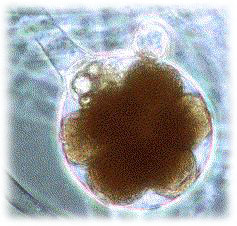
The phylum Myxomycota consists of plasmodia slime molds, which are more attractive than their name implies. Many species are brightly pigmented, usually yellow or orange, but slime molds are not photosynthetic; all are heterotrophs. The feeding stage of the life cycle is an amoeboid mass called a plasmodium, which may grow to a diameter of several centimeters. Large as it is, the plasmodium is not multicellular; it is known as a coenocytic mass, a multinucleate continuum of cytoplasm undivided by membranes or walls. In most species, the nuclei of the plasmodium are diploid and division are synchronous, with each of thousands of nuclei going through each phase of mitosis at the same time. Because of this characteristic, plasmodia slime molds have been used to study the molecular details of mitosis. Within the fine channels of the plasmodium, cytoplasm streams first one way, then the other; in pulsing flows that are beautiful to watch through a microscope The cytoplasmic streaming apparently helps distribute nutrients and oxygen. The plasmodium engulfs food particles by phagocytosis as it grows by extending pseudopodia through moist soil, leaf mulch, or rotting logs. If the habitat of a slime mold beings to dry up or there is no food left, the plasmodium ceases growth and differentiates into a stage of the life cycle that functions in sexual reproduction.

